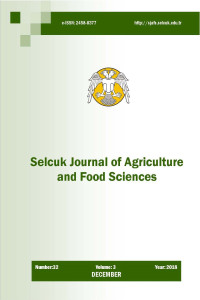Correlation and Path Coefficient Analysis of Phenological, Agronomic and Morphological Traits of Cumin and Ajwain Populations in Iran
Öz
Trachyspermum ammi (L.) and Cuminum cyminum area herbaceous herbs belong to the family of Apiaceae and belonging to the family Apiaceae, are one of the earliest cultivated herbs in Asia, Africa and the Mediterranean countries. They are widely used in foods, beverages, perfume, and pharmaceutical industries. This research was carried out in a randomized complete block design with three replications at Research Station of the Agricultural Research and Education Center of Khorasan Razavi, Iran during 2012-2013. In this experiment, genotypes of Ajwain (27) and Cumin (24) from different parts of the country were collected by the Natural Resources Genes Bank of Iran. This study aims to evaluate the morphological and phenological traits and also to measure essential oil percentage, yield and yield components of herbs for achieving superior germplasms. Seed samples were first cultivated in the greenhouse and then transferred to the field and cultivated in drip irrigation conditions. Studies showed there was a difference among investigated ecotypes of Ajwain and Cumin for following characters including plant height, number of branches, number of umbels, number of umbellate in umbels, biological yield, single plant yield, and for number of secondary branches and oil content at 5% probability level. In Ajwain genotypes, the highest direct positive effect (0.39) on the essential oil yield was observed for the total plant weight, which had a positive and high correlation (r=0.53) with day to maturing stage. The number of branches and number of umbels per plant had the most direct effect on grain yield and essential oil, and therefore were identified as a suitable criterion for determining the production ability of cumin genotypes. As plant biomass has the highest positive direct effect on the yield of essential oil of genotypes, the selection of these traits should be considered with greater attention and emphasis in breeding programs. Cluster analysis and PCA were used for distance between accessions and to emphasize variation and bring out strong patterns in the dataset. The first two components were justified 71% in cumin and 78% of the total changes in variables. Traits of canopy cover, plant height, plant weight and essential oil percentage were the most important traits in cumin. The flowering stage, Seedling stage, 1000 seed weight and essential oil percentage were the important traits of component one in the Ajwain accessions. Cluster 2 contained the accession with the maximum yield of essential oil.
Anahtar Kelimeler
Path analysis Essential oils diversity Physiological maturity Correlation
Ayrıntılar
| Birincil Dil | İngilizce |
|---|---|
| Konular | Bitki Bilimi |
| Bölüm | Araştırma Makalesi |
| Yazarlar | |
| Yayımlanma Tarihi | 28 Aralık 2018 |
| Gönderilme Tarihi | 10 Haziran 2018 |
| Yayımlandığı Sayı | Yıl 2018 Cilt: 32 Sayı: 3 |
Kaynak Göster
Selcuk Journal of Agriculture and Food Sciences Creative Commons Atıf-GayriTicari 4.0 Uluslararası Lisansı (CC BY NC) ile lisanslanmıştır.

